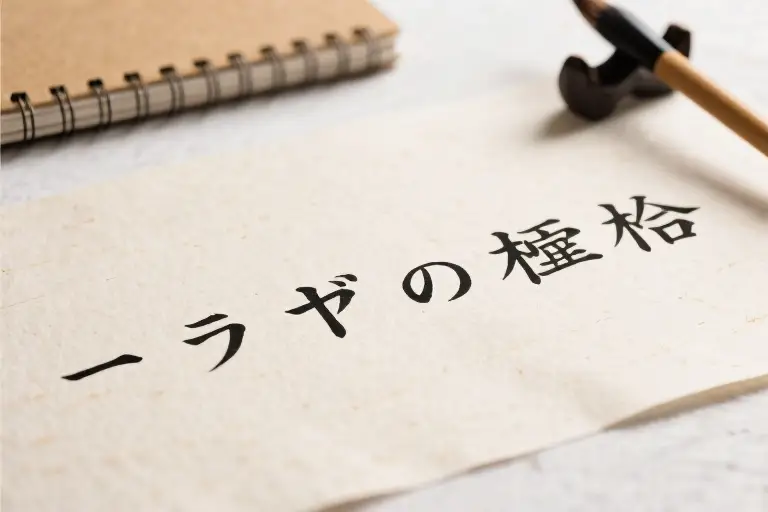Have you ever stared at a language textbook and thought, “This looks impossible”? For many English speakers, that moment comes when they first encounter Japanese kanji – those intricate characters that seem more like abstract art than a writing system. I know that feeling well. After comfortably mastering French, Italian and Spanish during my university years, I deliberately chose the road less traveled: in 2002, I packed my bags for Tokyo, ready to tackle what many consider one of the most challenging writing systems for Western learners.
What drives someone to abandon the familiar territory of Romance languages for the complex world of kanji? For me, it was the irresistible allure of a completely different way of thinking encoded in those strokes. While alphabets represent sounds, kanji represent meaning itself – whole concepts captured in visual symbols. The character 愛 (ai) doesn’t just spell “love” phonetically; it embodies the idea through its very form.
Let me share a moment that perfectly illustrates the kanji learning experience. During my first week in Japan, I confidently read what I thought was a “train” sign (電車) only to later discover I’d confused it with a completely different character combination. That humbling experience taught me something valuable: kanji aren’t just obstacles to overcome, but puzzles to solve, each with its own logic and history.
Consider this: the simplest kanji, 一 (ichi), is a single horizontal line meaning “one,” while the most complex common kanji, 鬱 (utsu, meaning “depression”), contains a staggering 29 strokes. Between these extremes lies an entire universe of meaning, where the number and arrangement of strokes tell stories about human civilization. The character 森 (mori), meaning “forest,” stacks three tree radicals (木) to visually represent dense woodland – a perfect example of how kanji combine logic with poetry.
Why does this matter for language learners? Because understanding kanji fundamentally changes how you process written Japanese. Where alphabetic writing flows linearly, kanji create mental shortcuts – you don’t read each stroke, but recognize patterns and components, much like identifying faces rather than individual features. This cognitive shift, while challenging at first, ultimately makes reading Japanese faster and more intuitive than you might expect.
My journey from Romance languages to Japanese wasn’t about abandoning one for the other, but expanding my understanding of how humans communicate. Those 2,000+ kanji that seem so daunting at first gradually reveal themselves as an interconnected system, where learning one character illuminates dozens of others. Take 日 (nichi, “sun” or “day”), which appears in 時間 (jikan, “time”), 日本 (Nihon, “Japan”), and even 日曜日 (nichiyoubi, “Sunday”) – suddenly, what seemed like memorization becomes pattern recognition.
As we explore these characters together, you’ll discover that kanji difficulty is often misunderstood. Yes, they require different mental muscles than alphabets, but they also offer unique rewards. When you learn that 駅 (eki, “station”) combines the “horse” radical with a phonetic component hinting at its ancient function as a post station, you’re not just learning a word – you’re uncovering layers of cultural history. That’s the magic waiting in every kanji character.
From Romance Languages to Japanese: My Linguistic Leap
Studying French, Italian, and Spanish felt like moving between neighboring countries – similar grammar structures, shared vocabulary roots, and that comforting familiarity of alphabets tracing their lineage back to ancient Rome. For years, I navigated these Romance languages comfortably until a growing restlessness made me crave something radically different.
The Turning Point
During my third year studying European linguistics, I stumbled upon a Japanese calligraphy exhibition. Watching ink transform into meaning with each deliberate stroke sparked an epiphany: here was a writing system that didn’t just record sounds but visually encapsulated ideas. Where our alphabet required combinations of letters to form words, these elegant symbols stood as complete visual concepts – trees (木), rivers (川), even abstract notions like love (愛) materializing through brushstrokes.
First Encounters with Kanji
My initial attempts at learning Japanese characters resembled solving miniature puzzles. Unlike memorizing verb conjugations, each kanji demanded three-dimensional understanding:
- Visual recognition (the character’s shape)
- Semantic meaning (its core concept)
- Pronunciation (often multiple readings)
That moment when I realized 山 meant “mountain” not because it sounded like “yama” but because the character literally depicted peaks? Pure linguistic magic.
Culture Shock in Tokyo
Arriving in Japan with textbook knowledge proved humbling. At Shinjuku Station, I confidently read the sign for “駅” (eki – station) only to discover locals pronounced it “sutēshon” in conversation. This duality – written formality versus spoken practicality – became my first lesson in Japanese linguistic layers.
Three memorable early mistakes:
- Confusing 切手 (kitte – stamp) with 手紙 (tegami – letter)
- Misreading 大人 (otona – adult) as “big person” literally
- Writing 先生 (sensei – teacher) with inverted strokes
Each error taught me that kanji aren’t just vocabulary – they’re cultural artifacts containing centuries of social evolution.
Why This Matters for Learners
For Western language students considering Japanese, understanding these aspects early prevents frustration:
- Cognitive shift required: Moving from phonetic to visual-semantic processing
- Cultural embeddedness: Characters often reflect historical contexts (e.g., 電車 densha – “electric vehicle” for train)
- Practical compromise: Even natives don’t know all 50,000+ characters – focus on the 2,136 joyo kanji
What began as academic curiosity transformed into respect for how language shapes thought. Those intricate strokes stopped being intimidating puzzles and became windows into a different way of organizing reality – one symbol at a time.
The Kanji System: Symbols That Think
When I first encountered Japanese kanji, it felt like discovering an entirely new way to communicate. Unlike the alphabets I’d mastered in French and Spanish, these intricate symbols weren’t just representing sounds—they were visual ideas frozen in ink. This revelation changed how I understood language itself.
The Three Dimensions of Kanji
Every kanji character operates on three interconnected levels:
- Form (形)
The physical structure that often hints at meaning through radical components. The character 休 (rest) combines 人 (person) leaning against 木 (tree)—a poetic visual metaphor. - Sound (音)
Multiple pronunciation layers including:
- On’yomi: Chinese-derived readings (e.g., 人 as “jin” in 人口/jinkō/population)
- Kun’yomi: Japanese native readings (e.g., 人 as “hito” meaning person)
- Meaning (義)
The core concept, which may shift slightly in different contexts. 生 can mean “life,” “birth,” or “raw” depending on usage.
Visual analogy: Think of kanji like emoji with academic credentials—😊 conveys happiness instantly, just as 山 immediately suggests “mountain.”
How Kanji Differ From Chinese Characters
While sharing common ancestry, Japanese kanji evolved distinct features:
| Feature | Chinese Hanzi | Japanese Kanji |
|---|---|---|
| Simplification | Some characters differ (e.g., 门 vs 門) | Retains more traditional forms |
| Usage | Standalone meaning | Often combines with hiragana (送り仮名) |
| Pronunciation | Single system | Multiple reading systems |
A concrete example: The character 飲 (drink) appears in both languages, but in Japanese it’s commonly paired with hiragana as 飲む (nomu), while Mandarin uses it independently as 喝 (hē).
Why This Matters for Learners
Understanding these mechanics helps overcome the initial overwhelm:
- Radical recognition unlocks meaning (e.g., 氵 indicates water-related characters like 海/sea)
- Stroke order rules (top→bottom, left→right) actually aid memory through muscle retention
- Contextual flexibility means one character can serve multiple purposes (e.g., 日 as “sun,” “day,” or even “Japan”)
Pro tip: When you encounter a new kanji, ask three questions:
- What components do I recognize?
- How might these parts suggest meaning?
- Where have I seen this in different words?
This systematic approach transformed kanji from mysterious scribbles into logical building blocks during my studies. What seemed impossibly complex became an engaging puzzle—one where each new character learned reveals connections to dozens more.
The Stroke Journey: Secrets of 24 Kanji Characters
1-10 Strokes: Building Blocks of Kanji
Let’s start with the foundation. These first ten characters demonstrate how Japanese builds meaning through incremental complexity. Each additional stroke adds new dimensions to the character’s story.
- 一 (1 stroke) – The simplest kanji meaning ‘one’. Just a single horizontal line, yet it appears in over 100 compound words.
- 人 (2 strokes) – Meaning ‘person’, this character visually resembles a walking figure. Notice how the two strokes support each other.
- 土 (3 strokes) – ‘Earth’ or ‘soil’, with horizontal lines representing the ground and a vertical stroke suggesting growth.
- 月 (4 strokes) – ‘Moon’ or ‘month’, originally depicting a crescent moon. Its curved strokes show kanji’s pictorial origins.
- 半 (5 strokes) – Meaning ‘half’, combining the radicals for ‘eight’ and ‘divide’ – a perfect example of kanji logic.
- 百 (6 strokes) – ‘Hundred’, where the top represents a white (pure) count according to ancient etymology.
- 初 (7 strokes) – ‘First’ or ‘beginning’, combining clothing (衤) and knife (刀) radicals to symbolize cutting cloth for a new garment.
- 金 (8 strokes) – ‘Gold’ or ‘metal’, with strokes representing ore in the earth (土) under a shelter (人).
- 度 (9 strokes) – ‘Degree’ or ‘times’, showing a hand (又) measuring cloth (巾).
- 時 (10 strokes) – ‘Time’, combining sun (日) and temple (寺) to represent the ancient practice of tracking shadows.
Each character tells a visual story. Notice how components reappear – the ‘sun’ radical (日) in 時 appears in over 50 common kanji.
11-24 Strokes: Cultural Stories in Ink
As we progress to more complex characters, we uncover deeper cultural connections:
- 週 (11 strokes) – ‘Week’, showing movement (辶) around a cyclical concept (周).
- 番 (12 strokes) – ‘Turn’ or ‘number’, depicting rice fields (田) being counted with a tool (釆).
- 数 (13 strokes) – ‘Number’, combining woman (女), right hand (又), and cultural significance of counting in ancient households.
- 駅 (14 strokes) – ‘Station’, a Japan-original kanji showing horses (馬) at a resting place (尺).
- 横 (15 strokes) – ‘Side’ or ‘horizontal’, with tree (木) and yellow (黄) radicals suggesting autumn leaves spreading sideways.
- 機 (16 strokes) – ‘Machine’ or ‘opportunity’, weaving together threads (糸) and wood (木) with other components showing mechanical complexity.
- 館 (17 strokes) – ‘Building’, where food (食) and official (官) radicals reveal its use for restaurants and government buildings.
- 難 (18 strokes) – ‘Difficult’, appropriately complex with its combination of bird (隹) and torch (灬) radicals.
- 議 (19 strokes) – ‘Deliberation’, combining words (言) with righteousness (義) – essential for Japanese business culture.
- 競 (20 strokes) – ‘Compete’, showing two standing figures (立) racing – common in sports terminology.
- 驚 (21 strokes) – ‘Surprise’ or ‘astonishment’, with horse (馬) and whip (攵) radicals depicting a startled horse.
- 籠 (22 strokes) – ‘Basket’, its bamboo (⺮) radical and complex structure demonstrating traditional craftsmanship.
- 襲 (23 strokes) – ‘Attack’ or ‘inherit’, combining dragon (龍) and clothing (衣) for dramatic imagery.
- 鑑 (24 strokes) – ‘Mirror’ or ‘specimen’, with metal (金) and oversee (監) radicals reflecting precision.
The 29-Stroke Marvel
Meet 鬱 (29 strokes) – meaning ‘depression’ or ‘gloom’. Ironically, learning it might cause exactly that! But breaking it down helps:
- Contains tree (木), wine (鬯), and cover (冖) radicals
- Represents trees growing densely (depression’s ‘heavy’ feeling)
- Used in medical terms and classical literature
Pro tip: Focus on radicals. 鬱 contains 木 (tree) repeated four times – spotting patterns makes even complex kanji manageable.
Why This Matters
Understanding stroke progression:
- Reveals kanji’s building-block logic
- Shows how meaning compounds visually
- Provides memory anchors through radical patterns
- Demonstrates cultural values embedded in writing
From the simplicity of 一 to the complexity of 鬱, each stroke carries intention. Tomorrow we’ll explore practical methods to memorize these – starting with just five daily characters makes 2000 achievable within two years.
Making Kanji Less Intimidating: Practical Learning Strategies
Memorizing thousands of complex characters doesn’t have to feel like climbing Mount Fuji without oxygen. After helping hundreds of language learners navigate Japanese writing systems, I’ve distilled three battle-tested approaches that transform kanji from frightening symbols into familiar friends.
The Visual Storytelling Method
Our brains remember stories 22 times better than isolated facts. Apply this to kanji:
- Identify components – Break down 駅 (station) into:
- 馬 (horse) left radical
- 尺 (measure) right component
- Create narrative – Imagine measuring horses at a 19th-century train station
- Add sensory details – Smell of hay, sound of steam whistles
Pro tip: Exaggeration helps. The weirder your story, the stronger the memory.
The Building Block System
Kanji aren’t random scribbles – they’re Lego-like constructions:
| Component | Meaning | Example Kanji |
|---|---|---|
| 日 | sun/day | 時 (time) |
| 月 | moon | 明 (bright) |
| 氵 | water | 海 (sea) |
Start with 50 foundational radicals (like these) rather than memorizing whole characters. Within weeks, you’ll recognize patterns in 60% of common kanji.
Daily Learning Rhythm
Consistency beats cramming. Try this 15-minute daily routine:
- Morning (5 min)
- Review 5 old kanji via spaced repetition app
- Trace 1 new character while saying its meaning
- Lunch (5 min)
- Spot kanji in wild (menus, manga, station signs)
- Night (5 min)
- Write new kanji 3x while visualizing its story
Tools That Actually Help
After testing 23 apps, these deliver real results:
- WaniKani – Gamified radical-first approach
- Kanji Study – Customizable stroke order drills
- Anki – Create personalized flashcards with mnemonics
Pitfalls to Avoid
- Stroke order neglect – Messy handwriting leads to misreading
- Meaning-only focus – Learn readings through vocabulary
- Isolated study – Always connect kanji to real-world usage
Remember: Even 鬱 (depression, 29 strokes) becomes manageable when broken into 木 (tree) + 缶 (can) + 鬯 (sacrificial wine). If that seems absurd, you’re doing it right – the sillier the association, the stickier the memory.
Your turn: Pick one kanji from our 24-character list and invent its origin story in the comments. Tomorrow, you’ll be surprised how vividly you recall it.
Let’s Start Your Kanji Journey Together
By now, you’ve seen how Japanese characters transform from simple lines to intricate symbols bursting with meaning. That 29-stroke character we started with? It’s no longer an abstract monster, but a fascinating puzzle waiting to be solved.
Your Turn to Begin
Every expert kanji learner started exactly where you are now – staring at that first character with equal parts excitement and nervousness. Here’s my challenge to you: pick just one kanji from our 24-character journey that speaks to you. Maybe it’s:
- 人 (person) – The foundation of all communication
- 月 (moon/month) – Connecting nature and timekeeping
- 駅 (station) – Your gateway to Japanese urban life
Write it down. Trace its strokes. Notice how its shape connects to its meaning. That’s how every Japanese learner begins.
Where to Go From Here
For those ready to dive deeper, here’s what worked for me:
- The 5-Character Rule: Learn just five new kanji daily (that’s 1,825 in a year!)
- Context is King: Always study characters within real words (e.g., 時 + 間 = 時間/jikan/time)
- Make It Personal: Create stories for complex kanji (the 29-stroke 鬱/depression looks like a person 人 under a raining 雨 forest 林)
Next Steps in Your Language Adventure
In our next guide, we’ll decode the secret relationship between kanji and pronunciation – why 人 can be read as ‘hito’, ‘jin’, or ‘nin’ depending on context. You’ll discover how to:
- Spot phonetic clues in character components
- Master the 100 most useful kanji readings
- Avoid common pronunciation pitfalls
Until then, remember what Japanese teachers always say: 一歩ずつ (ippo zutsu / step by step). Which kanji will be your first step? Share your choice below!
Pro Tip: Snap a photo of your handwritten kanji and keep it as your phone wallpaper – you’ll memorize it faster than you think!




